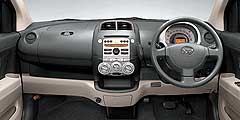First look: Sirion replacement a first
BY BRUCE NEWTON | 11th Jun 2004

This car is something of a landmark because it is the first to have been jointly developed by Daihatsu and its parent Toyota.
The car will be sold in Japan by Toyota Corolla dealers as the Passo - Italian for "step" or "footstep".
Through Daihatsu dealers it will be known as the Boon. (No, not named after Tasmanian cricketer David Boon, but after a sound that Japanese children use to imitate a car).
In Australia it will be sold only as a Daihatsu, but the local distributor has yet to confirm the Sirion name will continue.
Only 3595mm long, the five-door hatchback has a wheels-at-each-corner wheelbase of 2440mm and a miniature turning circle of 8.6 metres.
Daihatsu claims class-leading interior space and versatility, including a moveable rear seat cushion and 60:40 split folding rear seats.

The exterior is less individual, but strong safety claims are made with a lot of effort put into the compatibility, a big issue for people driving small cars. ABS with EBD (Electronic Brake-force Distribution) is also part of the safety package.
Two power sources are available at launch in Japan, a newly developed 1.0-litre codenamed 1KR-FE and the 1.3-litre K3-VE that’s already seen here in the YRV mini people-mover.
The 1.0-litre design, which includes continuously variable valve timing, produces 52kW at 6000rpm and 94Nm at 3600rpm. The 1.3, which also has continuously variable valve timing, produces 66kW at 6000rpm and 123Nm at 3200rpm.
Daihatsu claims miserly fuel consumption of as little as 21km per litre and that the engines easily comply with Japanese low emission vehicle standards. In Japan, the new vehicle is fitted only with a four-speed automatic transmission.
The front suspension uses MacPherson struts, while the rear-end has a torsion beam with a toe-correct function.
There is also a “Hokkaido” specification full-time four-wheel drive version that uses a rear suspension design comprising triple links and lateral rods.
The current generation 40kW 1.0-litre Sirion first went on sale in Australia in July 1998 and was facelifted in April 2002.
The 75kW 1.3-litre GTvi went on sale in September 2000 and was also facelifted in April 2002.
An all-new Sirion will be a timely boost for Sirion and Daihatsu, both of which dropped sales in 2003 after a strong 2002.
Daihatsu operations were integrated into Toyota Australia in July 2002. That move was triggered after Toyota Motor Company in Japan took control of Daihatsu in September 1998, raising its stake to 51.2 per cent of the shareholding.